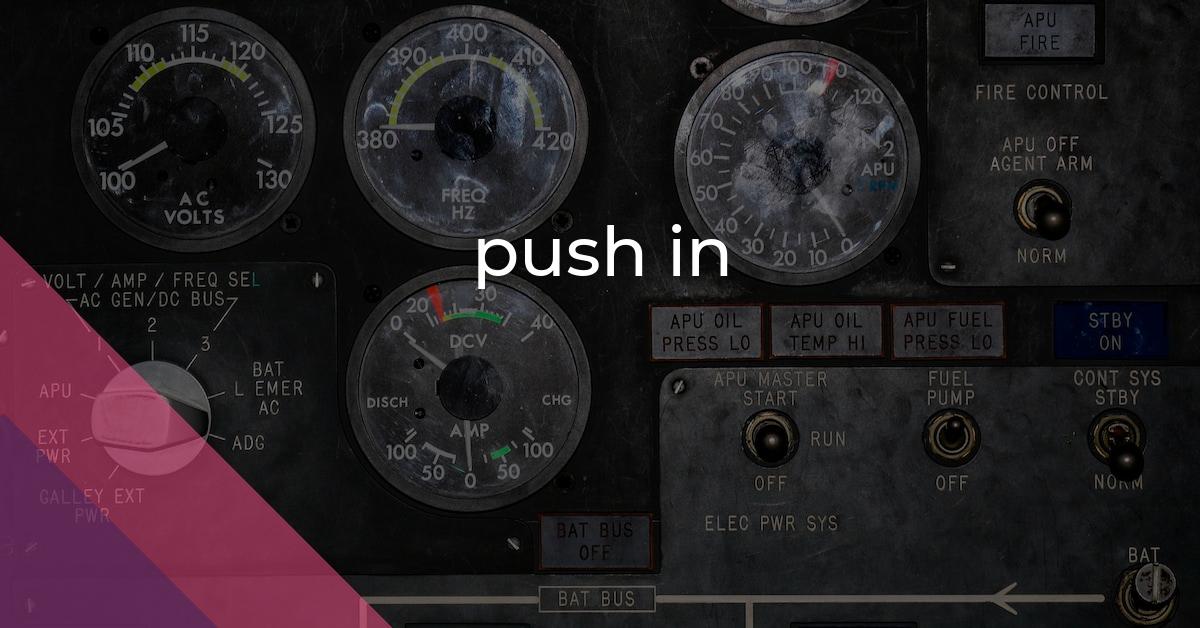push in: Idiom Meaning and Origin
What does ‘push in’ mean?
The idiom "push in" means to enter a line or queue without waiting for your turn or without permission. This action is considered rude or impolite.

Idiom Explorer
The idiom "take a number" means to wait in line or wait for one's turn. It implies that there are other people ahead and one needs to wait their turn patiently.
The idiom "rush in" means to enter or engage in something hastily or without considering the consequences.
An analysis of the idiom "push against an open door" reveals that it means to engage in unnecessary effort or resistance when the intended action would be easy or welcomed. This expression typically conveys the futility of opposing something that is already in agreement or easily attainable.
The idiom "pull up on" means to arrive or show up at a location, often unexpectedly or with a sense of urgency.
The idiom "pull up" means to stop or bring something to a halt. It can also refer to stopping oneself or someone else from behaving in a certain way. The phrase can be used in various contexts such as driving, sports, or correcting someone's behavior.
The idiom *pull the trigger* means to make a decision or take action, especially when it involves something significant or irreversible.
'Pull rank' is an idiom that means to use one's higher rank or position of authority to gain an advantage or to assert dominance over someone else.
The idiom "pull one's finger out" means to start taking action or making an effort after a period of inactivity or procrastination.
The idiom "pulling the plug" means to stop or end something abruptly or abruptly terminate a situation or activity.
Unveiling the Intricate Implications
The idiom "push in" is used in English to describe the act of entering or joining a line or queue without waiting or without following the established order. It is often used in a negative context to condemn the behavior of someone who bypasses others and jumps ahead in line.
One distinctive feature of this idiom is that it primarily appears in British English. In American English, the equivalent phrase is typically "cut in." However, it is worth noting that "push in" can still be understood and used in American English, albeit less commonly.
The etymology of this idiom suggests a literal interpretation rooted in physical action. The verb "push" conveys the act of applying force to move something or someone in a certain direction. In the context of "push in," it implies forcefully entering a line or queue by disregarding the normal procedure. This physical aspect of the idiom provides a visual representation of the action it describes.
While the idiom has a clear and straightforward meaning, it also carries a negative connotation. The act of pushing in is generally seen as impolite, disrespectful, and unfair to those who patiently wait their turn. It suggests a disregard for societal norms and a self-centered attitude. Thus, the idiom often serves as a criticism of individuals who display such behavior, highlighting their lack of consideration for others.
It is interesting to note that the idiom "push in" can be used metaphorically as well. In non-queue-related contexts, it can be employed to describe someone who forcefully interrupts or inserts themselves into a conversation, group, or situation without invitation or appropriate timing. This broader usage further emphasizes the negative implications associated with the idiom.
While the origin of the idiom remains somewhat unclear, it is plausible to assume that the literal action of physically pushing in line led to the development of its metaphorical usage. This connection between the literal and metaphorical meanings enhances the idiom's effectiveness in delivering its negative message.
"rush in" is another related idiom that shares similarities with "push in." While "push in" refers specifically to entering a line or queue without waiting, "rush in" can be seen as a broader term encompassing hasty and impulsive actions in general. Both idioms convey a negative connotation and emphasize the disregard for established order and consideration for others.
"jump the queue" is yet another related idiom that highlights the act of bypassing others and disregarding the established order. While "push in" and "cut in" often describe physically entering a queue, "jump the queue" can be interpreted as the act of skipping ahead of others in line, metaphorically or otherwise. This idiom also conveys a negative connotation, emphasizing the unfairness and lack of consideration associated with such actions.
Overall, these related idioms, including "push in," "rush in," and "jump the queue," serve as criticisms of individuals who bypass others and highlight the importance of respecting established norms and showing consideration in social interactions. They all convey negative connotations and suggest a disregard for others' rights and fairness in various situations.
Example usage
Here are three examples of how the idiom "push in" can be used in sentences:
- She tried to push in line at the grocery store, but the other customers were not happy.
- Can you please move your bag so I can push in and sit down?
- I don't want to push in, so I'll wait for the next available taxi.
More "verb" idioms



